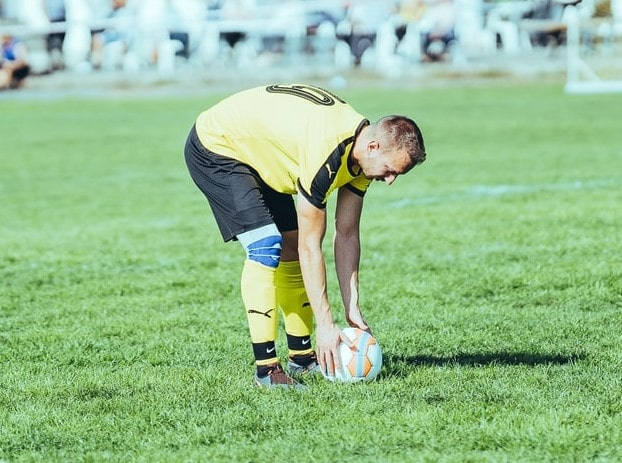Like any other well known sport around the world, soccer has its own rules and regulations that shape the game the way we know it today.
There are rules that are extremely well known and that define what soccer is all about, like the no handball rule for example, and there are other less known rules like the so called two-touch rule which I will be explaining in this article.
But before we talk about the two-touch rule, you should know that the name of this rule is just made up by the fans of the game and the rule doesn’t really have a name by itself, but the name “two-touch rule” describes the rule very well so I’ll be using this term till the rest of this article.
The two-touch rule in soccer is a rule that prevents a soccer player in some scenarios from touching the ball more than once till at least one other player has touched the ball too. The two-touch rule is put in action mostly when the ball is put back in play by one of the players on the field.
For example, let’s say that a player is taking a free kick in soccer, this player is only allowed to touch the ball once when they are taking the free kick. If they touch it a second time before the ball touches any other player on the field, then the referee blows their whistle.
When does the two-touch rule apply in soccer?
The two-touch rule applies to the player who is responsible for putting the ball back in play whenever it goes out of play due to a foul, a goal, or due to any other reason.
If you don’t know anything about how the ball is put back in play whenever the game stops, then you can check this article about the soccer rules which also includes details of how to put the ball back in play during a soccer game.

As mentioned before, the two-touch rule is applied almost whenever a player is putting the ball back in play. After the player touches the ball to put it in play, they shouldn’t touch it again unless someone else touched it after they did.
To make things simpler, here is when the two-touch rule applies in soccer:
- During a corner kick
- During a direct free kick
- During an indirect free kick
- During a goal kick
- During a penalty kick
- During kick-off
- During a throw-in
When a player is taking any of the above set-pieces, they are only allowed to touch the ball once until another player touches the ball. Or else, the game stops.
Note that there is only one specific way of putting the ball back in play that does not force the two-touch rule, and it is called the “drop ball”.
A drop ball occurs in soccer when the game stops for reasons that do not require the game to restart in one of the regular forms (free kicks, penalty kicks, goal kicks and so on). For example, if a fan enters the field of play and interrupts the game, then the game is restarted using a drop ball after the situation is handled.
Another example is if the ball hits the referee and the flow of the game gets affected.
If you don’t know what a drop ball is, it is basically just a way to restart the game. During a drop ball, the referee just gives the ball to one of the soccer players on the field while all other players stand away from the chosen player for at least a certain distance.
The chosen player is then allowed to touch the ball more than once even though they are the only player to touch the ball after the game restarted. In other words, the two-touch rule does not apply on the players that receive the drop ball.
However, it is worth noting that the player who receives the drop ball can’t score a goal unless the ball touches another player on the field.
One last scenario that I want to talk about here is related to the goalkeepers of each team.
If a goalkeeper has the ball in their hands, and then they give the ball to one of their players, then the goalkeeper is not allowed to touch the ball again with their hands until one of their opponent players touches it.
So in other words, a two-touch rule applies here too, but in a slightly different way.
If you are wondering about why this kind of rule exists for the goalkeepers, it’s simply to prevent the goalkeepers and their teammates from wasting the time left till the game ends.
If this rule did not exist, then a goalkeeper can just keep passing the ball to their teammate and receiving it back with their hands to hold it for a few seconds. The more they repeat the same pass, the more time they get to waste.
What happens if a soccer player breaks the two-touch rule?
If the player who is putting the ball back in play touches the ball twice before any other player touches the ball, then an indirect free kick is awarded to the opponent team.
As mentioned before, this doesn’t apply when a drop ball is rewarded because during a drop ball, the player is allowed to touch the ball more than once before it touches anyone else.
SUMMARY
The two-touch rule in soccer is a name given by the soccer fans to the rule that prevents soccer players from touching the ball twice when they are putting the ball back in play unless the ball touches any other player on the field.
If any player violates the two touch-rule, the referee gives an indirect free kick to the opponent team.

